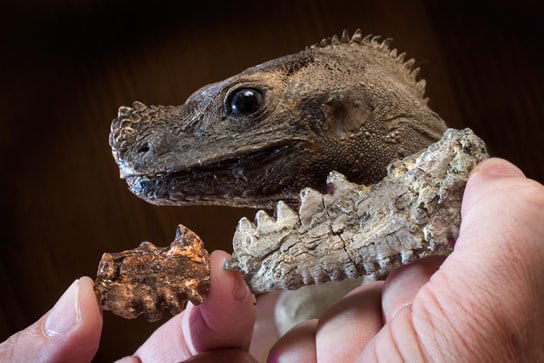
The cast of a fossil piece (right) is part of the jaw bone of Barbaturex morrisoni and is only about a quarter of the entire jawbone. At the left is the tip of the jaw bone. The lizard was researched by a team led by Jason Head, assistant professor of Earth and Atmospheric Sciences at the University of Nebraska-Lincoln. The lizard roamed the earth 40 million years ago, was six feet long and weighed upward of 60 pounds. Photo by Craig Chandler / University of Nebraska-Lincoln, University Communications
Paleontologists discovered the fossil remains of a giant lizard, Barbaturex morrisoni, which coexisted with mammals in the hot tropical forests of Southeast Asia some 40 million years ago.
Some 40 million years before rock singer Jim Morrison’s lyrics earned him the moniker “the Lizard King,” an actual king lizard roamed the hot tropical forests of Southeast Asia, competing with mammals for food and other resources.
A team of U.S. paleontologists, led by Jason Head of the University of Nebraska-Lincoln, describes fossils of the giant lizard from Myanmar this week in the scientific journal Proceedings of the Royal Society B. Their analysis shows that it is one of the biggest known lizards ever to have lived on land.
The creature’s scientific name is Barbaturex morrisoni — which means “Lizard King,” in honor of the aforementioned Doors singer.
At almost six (2 meters) feet long and weighing upwards of 60 pounds (27 kilograms), the lizard provides new and important clues on the evolution of plant-eating reptiles and their relationship to global climate and competition with mammals.
In today’s world, plant-eating lizards like iguanas and agamids are much smaller than large mammal herbivores. The largest lizards, like the giant, carnivorous Komodo dragon, are limited to islands that are light on mammal predators. It is not known, however, if lizards are limited in size by competition with mammals, or by temperatures of modern climates, Head said.
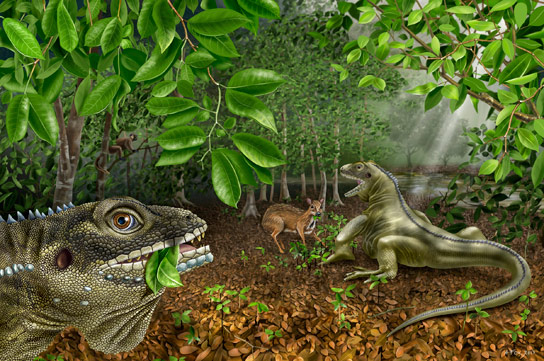
Artist’s rendition of Barbaturex morrisoni. Credit Angie Fox, Nebraska State Museum of Natural History, University of Nebraska-Lincoln.
But B. morrisoni lived in an ecosystem with a diversity of both herbivorous and carnivorous mammals during a warm age in Earth’s history — 36 to 40 million years ago — when there was no ice at the poles and atmospheric carbon dioxide levels were very high. The creature was larger than most of the mammals with which it lived, suggesting that competition or predation by mammals did not restrict its evolution into a giant.
“We think the warm climate during that period of time allowed the evolution of a large body size and the ability of plant-eating lizards to successfully compete in mammal faunas,” Head said.
“You can’t fully understand the evolution of ecosystems in the modern world without looking at the ones that preceded them. We would’ve never known this by looking at lizards today. By going back in time using the fossil record, we can find unique information on the origin of modern ecosystems.”
Head worked with Patricia Holroyd of University of California, Berkeley, Gregg Gunnell of Duke University, and Russell Ciochon of the University of Iowa on identifying and analyzing B. morrisoni.
It was a discovery millions of years and then a few extra decades in the making. Fossils of the giant lizard were discovered by Ciochon and colleagues in the 1970s in Myanmar, but were unstudied in the University of California Museum of Paleontology until a few years ago, when Head and Holroyd began looking into them.
When Head first examined the fossils, he noticed the creature’s bones were characteristic of a group of modern lizards that includes bearded dragons, chameleons, and plant eaters like spiny-tailed lizards.
“I thought, ‘That’s neat. Based on its teeth, it’s a plant-eating lizard from a time period and a place from which we don’t have a lot of information.’ But when I started studying its modern relatives, I realized just how big this lizard was. It struck me that we had something here that was quite large — and unique,” said Head, an assistant professor of earth and atmospheric sciences at UNL and a curator in the University of Nebraska State Museum of Natural History’s Division of Vertebrate Paleontology.
He noticed another telltale sign — ridges on the underside of the jaw that strongly suggested it supported soft tissues, much like the multicolored chin flaps and dewlaps that give some modern lizards a bearded appearance. The giant lizard’s genus name, Barbaturex, means “bearded king.”
“I was listening to The Doors quite a bit during the research,” Head said. “Some of their musical imagery includes reptiles and ancient places, and Jim Morrison was of course ‘The Lizard King,’ so it all kind of came together.”
Head said the discovery of B. morrisoni now leads to other big questions: For how long do these giant lizards persist in the fossil record? How far and wide did they disperse across the planet? What are the relationships of the evolution of reptile body sizes to changes in global temperature throughout history? And the obvious question — does a warming climate mean giant reptiles will someday return?
He said if we were to raise global temperatures at a natural pace and preserve natural, healthy habitats, we could end up with the evolution of giant lizards, turtles, snakes, and crocodiles.
“But we’re changing the atmosphere so fast that the rate of climate change is probably faster than most biological systems can adapt to. So instead of seeing the growth and spread of giant reptiles, what you might see is extinction,” he said.
Meanwhile, the researchers will consider how the clues provided by B. morrisoni can be used to reconstruct global temperature over geologic time periods.
“That becomes very important in modeling what temperature change will be like across the surface of the planet in the future,” Head said. “And that, obviously, bears directly on our own health.”
Reference: “Giant lizards occupied herbivorous mammalian ecospace during the Paleogene greenhouse in Southeast Asia” by Jason J. Head, Gregg F. Gunnell, Patricia A. Holroyd, J. Howard Hutchison and Russell L. Ciochon, 22 July 2013, Proceedings of the Royal Society B.
DOI: 10.1098/rspb.2013.0665
Image: Craig Chandler / University of Nebraska-Lincoln, University Communications; Angie Fox, Nebraska State Museum of Natural History, University of Nebraska-Lincoln

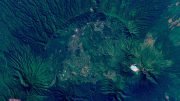


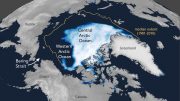
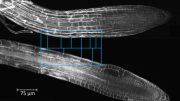


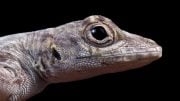
If crocodiles and giant reptiles of Pacific islands can exist today , it is possible for the hangover of giant reptiles of 60 million years ago, could survive along with their later cohabitants of mammals. Thank You.
Interesting read. Assuming they think it was an omnivore based on the picture of one earing leaves and the other about to eat a mammal